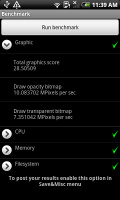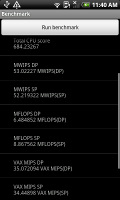Samsung I9000 Galaxy S review: From outer space
From outer space
User interface: TouchWiz takes Android to a new level
Third time is the charm for Samsung and Android. On the I9000 Galaxy S, the TouchWiz overlay is most prominent and it improves both looks and usability.
You shouldn’t expect a miracle of course – the user experience isn’t too different but many minor changes (and good ones at that) are there to be seen. The Android approach to touchscreen is pretty good to begin with, and the final result is excellent.



The TouchWiz 3.0 user interface comes preinstalled on top of the Android OS
The customizations start on the homescreen where you have up to seven panes to populate with widgets. In our earlier unit there were 9 screens available but Samsung obviously thought this was either too much for the device to handle or more than any user will need. The good part is that you don’t have to use all the screens all the time. If you need less, deleting the extra ones will speed up the navigation.

You can add up to seven panes on the homescreen
Unfortunately, the option to set a default homescreen that we saw on the Galaxy Spica is not available. With the Samsung I9000 Galaxy S, the default homescreen pane is the leftmost not the central one. So if you have used all the screen panes navigation will involve a lot of side-scrolling.
Samsung have also added 8 widgets of their own, available under “Samsung widgets” when adding content to your homescreen. Those include four different clocks (Calendar, Weather, Dual and Yahoo Finance).
There’s also the Feeds & Update widget (shows social network status updates), Days (lets you snap a photo and displays upcoming events and notes, great for reminders) and Buddies now, which is similar to Photo contacts. The final Samsung widget is Daily Briefing, giving you an aggregated view of weather forecasts from AccuWeather, stock rates from Yahoo Finance, news feeds from Associated press and your upcoming appointments.
Next, the Galaxy S has four buttons docked at the bottom of its homescreen, which stay there even when you open the menu. The rightmost button is the Applications/home button, which alternates the main menu and the home screen, and the other three you can change with whatever icon you like.
The main menu consists of side-scrollable panes, much like the homescreen, instead of a vertical scrollable grid (like in vanilla Android). You can add new pages manually, by dragging an app to a new screen in edit mode. A list view is also available, just as on the HTC alternative, Sense UI.
When the launcher is in edit mode, you can uninstall applications (only the ones that you installed) just by tapping them.
Additionally, the Samsung I9000 Galaxy S packs all the updates brought by Android 2.1, like several new widgets and Live wallpapers. The Galaxy S even has more live images than the Google Nexus One and some of the new additions are downright impressive (mostly the pond). Just keep in mind that activating living wallpapers will put a strain on the battery.
The task switcher has been untouched by the TouchWiz changes, but the notification area has Wi-Fi, Bluetooth, GPS and sound toggles on top. These are quite handy when you need to turn any of these features on or off – no more digging in the Settings.
Even better – if there are no known Wi-Fi networks available when you switch WLAN on, a tab appears that lets you pick a network. This makes connecting to any Wi-Fi network a breeze.
The lock screen has been TouchWizified as well – you now need to swipe upwards to remove the virtual lockscreen covering your phone. There are cool alternative unlocking patterns too when you have a missed event – a message or a call. Strangely enough though, this Samsung I9000 Galaxy S unit lacks the Smart Unlock functionality – something which our preview sample had.
Overall, the changes that TouchWiz brings to the table make Android easier to use. The docked icons are the fastest way to launch the most commonly used apps. The toggles in the notifications area let you easily switch off unneeded radios to save battery. And adding more homescreen panes only as you need them is better than having mostly empty screens. In short, we like what Samsung have done with the place.
The performance of the Samsung I9000 Galaxy S was great even in its early pre-release stages but the interface is now even faster and smoother. The Samsung Galaxy S 1 GHz Cortex A8 CPU is obviously doing a great job and the 512 MB of RAM on board feel more than enough. In case you are having RAM troubles (highly unlikely as it may be), you can download one of the free task managers from the Android Market and keep a tighter grasp on what’s using it.
Update 24 May: Initially our phone reported to have 256 MB of RAM memory, but after seeing so many sources claiming that the Galaxy S has 512 MB we contacted Samsung to clear this out for us. It turned out the Galaxy S will hit the shelves with good 512 MB of RAM on board.
The applications work consistently well and we can only imagine what a possible Froyo 2.2 update will do for the I9000 Galaxy S. Froyo is said to give a two to five times speed boost.
Check out the device in action in the video below that we snatched from our blog – lags are very rare and not affecting the user experience at all.
Finally, we ran the usual benchmarks on the Samsung I9000 Galaxy S and weren’t really surprised to see it get the best scores yet. The 1GHz Hummingbird processor isn’t miles ahead of the Snapdragon inside the Sony Ericsson XPERIA X10 and HTC Desire but it does have a slight edge.
Reader comments
- Sam
- 09 Oct 2023
- nw}
The Samsung galaxy s1 ís the best phone. It is called the Galaxy S, but I pronounce it as the S1. Sure it may have no flash, but for its looks, a good phone for anyone born in the 1990s
- Adam
- 19 Aug 2021
- KZJ
No.
- Anonymous
- 07 Aug 2021
- 8mu
Yes, you can install Lineage OS 14.1 based on Android 7












